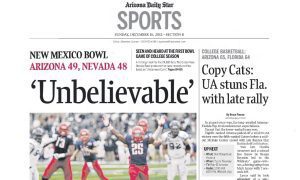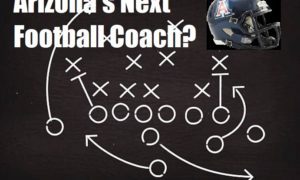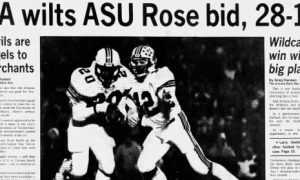|
|
|

Arizona coach Rich Rodriguez announced that the Wildcats will practice this week with copper helmets and wear them Saturday against Oregon State at Arizona Stadium (ArizonaWildcats.com screen shot)
Will Arizona strike gold on their red-zone opportunities against Oregon State? Perhaps it is more appropriate to ask will the Wildcats try to strike copper?
Arizona coach Rich Rodriguez announced Monday that the Wildcats will unveil their copper helmets for the first time at Arizona Stadium on Saturday when they play Oregon State.
Wearing the helmets will not help Arizona in its quest to rectify an 0-for-6 performance in the red zone in its 49-0 loss at Oregon last weekend. But as any Arizona historian will argue: The Wildcats would not have a red zone at Arizona Stadium if it weren’t for the copper mining industry in the state.
As was detailed in the No. 47 game of my recent Top 50 games in Arizona history, the school can thank the mining industry for the existence of Arizona Stadium.
After former UA football players Orville McPherson and Kirk Moore pitched the idea of the stadium to the Board of Athletics Control (composed of full-time graduate managers and representatives of the student body and faculty) in 1921, the Arizona Board of Regents purchased two blocks of land for the stadium at Sixth Street between Vine Street on the west and Cherry Street on the east.

Aerial shot of Arizona Stadium in 1941, 12 years after it was constructed (TucsonCitizen.com archive photo)
The Board of Regents stipulated that the alumni must raise $100,000 toward the stadium’s cost. The school’s president Homer LeRoy Shantz used the theme, “We must pull together” to gain support. Football coach J. F. “Pop” McKale was very active in this campaign, yet alumni, faculty and students pulled together only $25,000 toward the $100,000 goal.
The copper companies in Arizona helped the school reach its goal with their donations. In 1929, the Wildcats played their first game in Arizona Stadium — then known as “West Stadium” with a capacity of 8,000.
According to a university Web site, the major copper industry donors were United Verde Copper Company ($20,000), Phelps Dodge Company ($7,500), Inspiration Copper Company ($7,500), New Cornelia Copper Company ($4,370), Miami Copper Company ($4,000), Calument and Arizona Copper Company ($3,790), Nevada Consolidated Copper Company ($3,000), and Magma Copper Company ($2,500).
Arizona senior center Kyle Quinn, who earned a degree in history in May, endorses the use of the helmet.
“Being a history major, I know how important the copper industry is to this state,” he said in the weekly press conference at McKale Center.
Copper mining in Arizona has been a major industry since the 1800s. In 2010, Arizona continued to be the leading copper-producing state in the country. The industry is worth $34.2 billion to the U.S. economy ($12.1 billion to Arizona’s economy). Arizona produced 63 percent of the copper in the U.S.
When asked if he liked the appearance of the helmet, Quinn quipped: “Linemen get torn up any way. It doesn’t matter what helmet I am wearing.”
Arizona quarterback Matt Scott said he liked the helmet but remarked that the “A” should be larger.
“I think you can’t wear red (jerseys) with it; you have to go blue,” Scott added with a smile. “It really doesn’t matter what we wear, we still have to go out there and play.”
The Wildcats must not only play but cash in on their red zone opportunities, which led to their demise at Oregon.
Arizona’s woes were so horrific that UTEP coach Mike Price, formerly of Washington State, made a comment about the Wildcats’ shortcomings on Sirius/XM’s College Sports Nation this morning.
“How about Oregon-Arizona? Isn’t Arizona in the red zone seven times (actually six) and come up blank?” Price said. “Oh my God, what do you think they’re working on this week in practice?”
The comment drew a chuckle from host Jack Arute and analyst Rick Neuheisel.
Site publisher, writer and editor Javier Morales is a former Arizona Press Club award winner
|
|



























